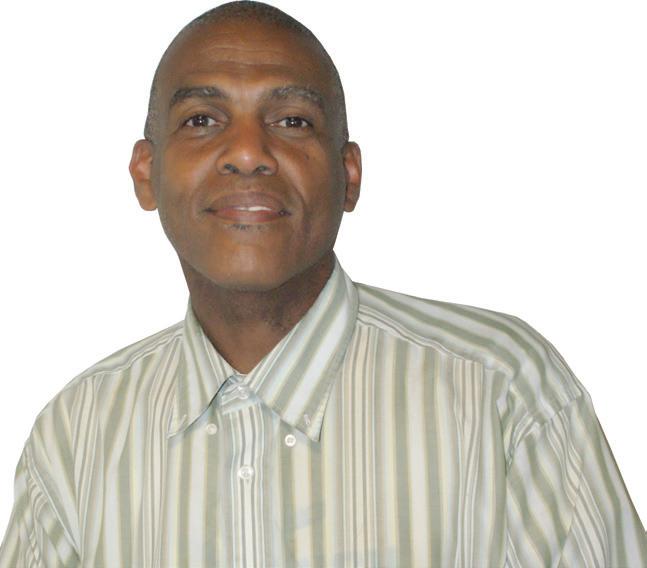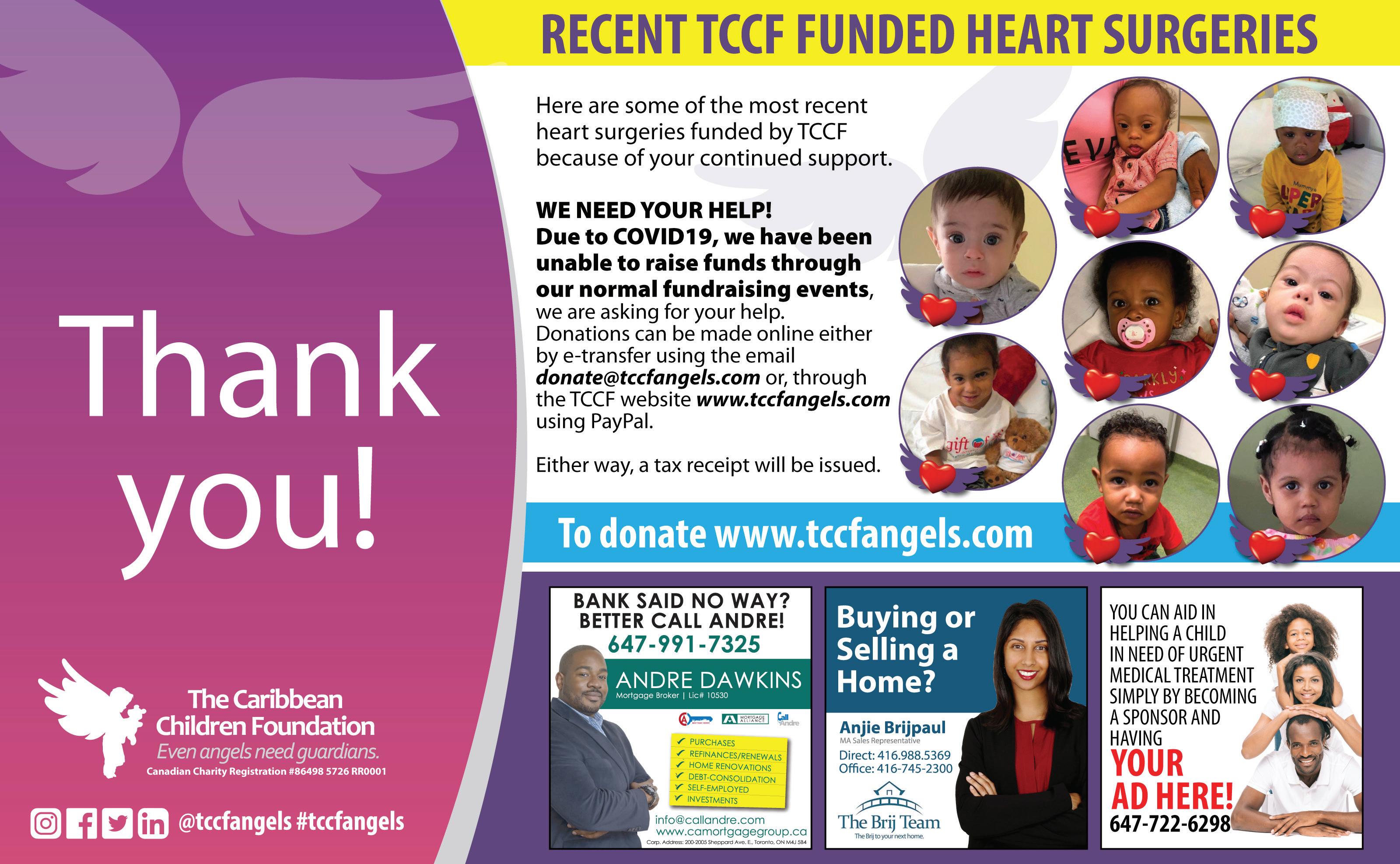








Mandatory COVID-19 vaccine policies have had damaging effects on: public trust, vaccine confidence, political polarization, human rights, inequities and social wellbeing...”












Mandatory COVID-19 vaccine policies have had damaging effects on: public trust, vaccine confidence, political polarization, human rights, inequities and social wellbeing...”


My interview with this edition’s Women Empowered is a long time coming. She is a dynamic entrepreneur with a passion for natural beauty and business innovation. Born and raised in Scarborough, Ontario, to Trinidadian immigrants, Lisa Keizer is the youngest of three go-getter sisters. Her upbringing in a vibrant, multicultural community has greatly influenced her approach to life and business. With a deep appreciation for her heritage and a keen eye for opportunity, Lisa set her sights on creating something extraordinary.
A natural-born entrepreneur, Lisa has had an entrepreneurial approach to all things in her life. In her 20’s, she left a corporate job to pursue missions abroad, training in Alberta and Los Angeles for urban ministry. Returning home in the early 2000’s marked the beginning of her non-profit career, where she later became the Director of Development for Christian organizations.
Her parents, Elliott and Althea Redhead, were givers and community people who left a legacy of generosity for Lisa and her sisters. Because of this, giving back is built into the very DNA of her company Up North Naturals. Lisa attributes much of her success to the family she grew up in and what was passed down to her through the generations.
In 2015, Lisa founded Up North Naturals, a company dedicated to providing high-quality, natural hair care products specifically designed for: curly, kinky, and coily hair textures. As the Director of Business Development, she has been the driving force behind the brand’s rapid growth and success. Lisa’s entrepreneurial spirit and unwavering commitment to excellence have propelled Up North Naturals to become a beloved and trusted name in the natural hair community. Lisa and her husband became parents through adoption after many years of trying, and she now advocates for adoption, especially among people of colour.
Lisa’s journey has been marked by resilience, creativity, and a genuine desire to make a positive impact. She draws inspiration from her family’s strong work ethic and her cultural roots, which have helped her, create a brand that resonates with customers on a personal level. Naturally, a discussion was set up to learn more about this incredibly brave, and persistent entrepreneur, and I must say that I walked away a little wiser than how I came into the discussion.
“Creating,” Lisa tells me. “Creating ideas and seeing them actually work. I have
always been entrepreneurial. I worked in nonprofits and did things very different, and this is what advanced me. I always wanted to do something a little bit more meaningful. I used to work at Sprint Canada, but soon discovered that I needed a change. I worked with nonprofits that raised money for children, and I also worked with the Scarborough Chamber of Commerce.
“Something not many people know about me is that I loved musical theater, and I pictured myself taking that further when I attended Sheridan College in Oakville. If I was going to spend my time on something it had to be something that I loved. I liked to sing. I grew up in a home where my parents were always singing.”
“I am a mom through adoption, and that is a huge part of me. I always dreamed of being a mom, and I always wanted to have a lot of kids. Children didn’t happen for me naturally, so I have a soft spot for those women who this doesn’t happen for, and I encourage women to adopt. We ended up getting Joshua. It was such an amazing process, and getting to the point to ask ‘Can I do this?’ I struggled with my relationships with my girlfriends because I couldn’t relate. I felt very awkward, and I ghosted a few times. It was hard. Things were not sitting right. Something was missing. There is not a lot of Black women who adopt, and I want to be open so that if they have questions.”
“Can you describe the process of developing your first product? What was the initial feedback from your customers like?”
“The first product I made was Flaxseed Gel. My parents used to make a lot of tonics and were very healthy. I used YouTube and I remember marching it across to my friend and telling her to try it. She was like, you made it? I was just so proud of myself.”
“My first commercial product was a leave-in conditioner, and I worked with a chemist on this. It needed preservatives so I needed some help on it.”
“What were some of the biggest challenges you faced when starting Up North Naturals, and how did you overcome them?”
“It was making sure I had the cash flow. networking and creativity was there, but then it was getting products together. It was about starting small. Then I would get an order for 24 bottles of something. How was I going to do it? This is when I had to really strategize.”
“Up North Naturals has grown significantly since its inception. What do you attribute

this growth to, and what are your future plans for the company?”
“Persistence. I am persistent to a fault. I don’t give up easily. I push myself. I have a goal in my mind, and I will write it down. I heard no from a major retailer last week, and I was like how did I hear no after coming this far. I went back to the distributor and asked for a test market. Either give me something small, provide me with something new, give me something. I let them know that I am persistent. I lay myself out there, and I don’t care what people think.”
“What advice would you give to other entrepreneurs who are looking to start their own natural product lines?”
“Keep going with your ideas, don’t give up on something, just ask for something else. What you want is not what you are going to actually get. Nurture your connections; it is something that I have to work on. I tend to isolate and keep my head down a lot.”
Her future goals include nurturing young entrepreneurs interested in taking similar paths and establishing an initiative that brings founders in the beauty business together to give back to the community. With her infectious enthusiasm and steadfast dedication, Lisa Keizer continues to inspire others to embrace their natural beauty and pursue their dreams. Her story is a testament to the power of determination and the importance of staying true to one’s values and God-given talents.
When she’s not busy developing new products, or strategizing the next big move for her company, Lisa enjoys spending time with her family, exploring nature, and connecting with her new community in Northumberland County. With a husband who is a beekeeper and avid gardener, they are appreciating the fruits of their labour literally.
If you are interested in learning more about Lisa’s natural journey, you can email her at Lisa@upnorthnaturals.com, or if you need product information, Lisa is waiting to hear from you, and you can also reach out to her at Care@





During the COVID-19 pandemic, mainstream media over played their role in keeping the public informed. From infection rates to vaccine rollouts, the news was: relentless, intense, and pervasive. They highlighted the strain on healthcare systems, the race for vaccines, and the importance of public health measures. The urgency was palpable, and they ensured that the coverage reflected the gravity of the situation.
Fast forward three years, and as the world emerges from the shadow of the pandemic, the focus of mainstream media has shifted. The intense scrutiny of government actions and decisions during the pandemic has waned, replaced by a return to pre-pandemic norms. There are numerous fallouts from how our governments handled the pandemic. Economic repercussions, mental health crises, and questions about the efficacy and transparency of governmental decisions especially when it comes to the COVID-19 vaccine. Yet, these stories are not being sensationalized. The media’s spotlight has dimmed on these critical issues.
This is a far cry from what was being done during the pandemic. The selective lens of mainstream media means that as
consumers, we need to be more vigilant. We must pay attention to how they are picking and choosing what we know about how the world really works. This week, we want to dive into another round of discussions when it comes to the COVID-19 (vaccines) injections.
As early as January 2022, National Institutes of Health (NIH) researchers were aware of at least 850 peer-reviewed case reports and/or research articles about COVID-19 vaccine reactions. This is according to emails obtained by Children’s Health Defense (CHD). The January 9th, 2022, email included a list of “persistent symptoms following the Covid vaccines” and the names of researchers who were studying these conditions, which included:
• Dysautonomia: Dysautonomia is a nervous system disorder that disrupts autonomic body processes. These are automatic functions like your blood pressure and heart rate. Having dysautonomia means these functions don’t work properly, causing disruptive symptoms. These symptoms are often manageable, but diagnosing and treating dysautonomia is sometimes difficult.
• Neuropathy
• Tinnitus
• Multisystem inflammatory syndrome (MIS): Multisystem inflammatory syndrome (MIS) is a rare but serious condition associated with SARS-CoV-2, the virus that causes COVID-19, in which different internal and external body parts become inflamed (heart, lungs, kidney, brain, skin, eyes, gastrointestinal tract)
• Myocarditis
• Blood clots
• Paresthesia
The emails were part of a 309-page batch of documents released to CHD that originated from the U.S. Food and Drug Administration (FDA) requested NIH researchers for input on a report highlighting several injuries common among people who received the vaccines. CHD requested the documents via a Freedom of Information Act (FOIA) request to the NIH in November 2022. When the NIH hadn’t responded by April 2023, CHD sued the agency. What I most recently found out is that the National Institutes of Health (NIH) corresponded with people injured by the COVID-19 vaccines throughout 2021 and initially acknowledged their injuries. All of a sudden abruptly ceasing communication with them in early 2022.
The NIH filed a motion to dismiss the lawsuit, but in July 2023, withdrew its motion and agreed to release the documents, but only after NIH officials on two occasions claimed the agency had no knowledge of “adverse vaccination reaction reports. In an October 2023 settlement, the NIH agreed to produce up to 7,500 pages of documents at a rate of 300 pages per month.
None of this is good news, and now more than ever “Empathy, and investment is needed to address vaccine-related injuries,” says Harvard T.H. Chan School of Public Health’s Kizzmekia Corbett-Helaire.
Kizzmekia Corbett-Helaire, assistant professor of immunology and infectious diseases, was one of the developers of the COVID-19 vaccine. On an episode of STAT News’ First Opinion podcast, she discussed
her experience working on the vaccine, her path to a career in science, and her approach to being a role model as a Black woman in science. She also talked about her opinion piece in STAT, in which she wrote that she believes more empathy is needed for people who report experiencing long-term side effects from the COVID-19 vaccine.
In the STAT piece, Kizzmekia listed concrete steps that everyone in the vaccine field — herself included — should take. These steps include establishing a better system through which people can report vaccine-related injuries, creating and widely distributing guidelines for healthcare providers to better communicate with and care for patients who experience these injuries, and conducting more and deeper scientific investigations into these injuries. Such investigations, she added on the podcast, would not hamper further development of vaccines. Rather, they would further the quality and effectiveness of vaccines, as well as bolster public trust.
What I appreciate about Kizzmekia is that even though she is partly responsible for the development of the vaccine, she is not afraid to admit that there are certain aspects of what has happened that must be addressed.
As media consumers, it is our responsibility to seek out the full story. We must question the narratives presented to us and demand comprehensive reporting. Only then can we ensure that we are truly informed about the world we live in. The power of the media lies in its ability to inform and empower. Let us hold it to the highest standard, ensuring that every story, especially those that shape our future, is told.


BY RUSHANE FERRON
TORONTO CARIBBEAN REPORTER

One crown, thirteen parish Queens, and a night to remember - The 2024 Miss Jamaica Festival Queen will be crowned on Saturday, August 3rd, 2024, at the National Indoor Sports Centre. This is one of the major events of the annual Independence Festival celebrations to commemorate Jamaica’s 62nd anniversary of political independence.
The stage will be set, the lights will be bright, and the excitement will be palpable at the National Arena in St. Andrew on Saturday night as the competition will bring together the best and brightest of Jamaica’s young women. With thirteen parish queens vying for the prestigious and coveted crown, the event will be a spectacular showcase of beauty, talent, and cultural pride.
The competition, organized by the Jamaica Cultural Development Commission (JCDC), is a celebration of Jamaica’s rich cultural heritage and the incredible talents of its young women. Each contestant will bring a unique blend of intelligence, charm, and cultural awareness to the stage under the theme: “The Jamaican Woman, Creativity Beyond Boundaries.”
The evening will kick start with the introductory segment, where each queen will tell the audience the parish she is representing along with a funfact about herself. This will be followed by the talent segment, where the queens will impress the audience and judges with their extraordinary abilities with a: song, dance, or spoken word.
The evening wear segment will highlight a touch of glamour to

the competition. The queens will grace the stage in stunning gowns reflecting their elegance and sophistication. They will glide across the stage as the judges will assess not only their appearance, but also their poise and confidence.
The sectional awards will be presented for various categories such as: Most Congenial, Most Active in the Community, Most Poise, Most Culturally Aware, Most Popular on Social Media, Best Gown and Best Performance. Shortly after, the judging panel will make the selection of the top five queens who will then advance to the question-and-answer segment of the competition.
The final segment of the night will be the question-and-answer round, which will provide the contestants with the opportunity to articulate their visions for Jamaica’s future. From the top five selections, the top three will be crowned – the 2024 Miss Jamaica Festival Queen, the first and second runner up respectively.
The contestants are Miss Hanover- Sornia Samuel, Miss St. ElizabethOmoloro Wilson, Miss St. Thomas- Stephena Edwards, Miss St. Ann- Onecia Henry, Miss Portland- Tamesha Wilson, Miss Clarendon- Jenicia Jones, Miss Manchester- Shonnoya Houston, Miss Trelawny- Renata Hunt, Miss St. Mary- Shamoya Bailey, Miss Kingston & St. Andrew- Daindra Harrison, Miss Westmoreland- Sherona Small, Miss St. James- Toni-Shea Grey and Miss St. Catherine- Shahida Grant.
The JCDC in partnership with the Red Cross will collect monetary donations to aid with the St. Elizabeth recovery process.






















(volume dependent)


There was a recent controversial court ruling about the Fearless Fund, known for its dedication to funding African women entrepreneurs. They were ordered to cease providing grants exclusively. This decision has sparked heated debates about the future of targeted funding initiatives designed to level the playing field in the venture capital landscape. Despite these challenges, Black women continue to defy the odds, and today, I want to introduce an organization who is stepping up to fill the gap and support this dynamic group of entrepreneurs, but first let’s look at some interesting statistics.
Despite making up only 3% of the tech workforce, women of colour are the fastest-growing group of entrepreneurs in the United States. Even though they receive just 0.1% of venture capital funding, they are starting businesses at an impressive pace. Esosa Ighodaro and Regina Gwynn recognized the absence of a clear roadmap to billions for African-American/ Canadian women in tech, so they decided to create their own. This led to the birth of Black Women Talk Tech (BWTT). The idea took root in 2015 with the first “unofficial” Black woman founders’ retreat, which underscored the need for a more formal gathering.
In the fast-evolving world of technology Black Women Talk Tech (BWTT) has become a powerful and inspiring wave allowing African-American/Canadian women to make their mark, and lead the charge in the tech industry. The importance of BWTT cannot be overstated. In an industry where women of colour receive less than 1% of venture capital funding, BWTT highlights the unique challenges and immense potential of this group. The work that they do serves as a crucial platform for visibility, enabling Black women to showcase their innovations, connect with investors, and gain the mentorship needed to scale their businesses.
From coding to entrepreneurship, from data science to leadership roles, African-American/Canadian women are trans-
forming the tech landscape. Their contributions are not only driving innovation, but also bringing much-needed diversity and inclusion to the industry. This rise of African-American/Canadian women in tech is a reflection of their: resilience, determination, and unyielding spirit. Their significant advancement in this industry highlights the importance of representation and the impact of diverse voices in driving innovation.
Esosa and Regina had envisioned a space where African-American/Canadian women could come together to: share experiences, network, and inspire one another in an industry where they are often underrepresented and overlooked. The very first BWTT: Roadmap to Billions event took place at Google, with 30 attendees, and since has grown into an annual conference attracting over 1,300 attendees. For the past seven years, Roadmap to Billions has provided: education, inspiration, and opportunity for over 10,000 attendees, facilitated vital conversations between founders and investors, and created funding pipelines for over a dozen women pitch winners to receive nearly $30M in venture capital funding.
The next stop in their journey is taking them across the border as they host Roadmap to Billions in Toronto, Canada for the first time this September 2024. With a line-up of prominent Black females in the tech space and a growing roster of sponsors and partners, this event will open up a space for African-Canadian women in tech to find the support and resources they need to grow thriving ventures in Canada.
I am personally excited about this for our community here in Toronto, because as a community, we have struggled to embrace this digital revolution. I completely understand why; it is intimidating. That is why I am glad that we have intelligent women like Esosa and Reginal to help us with this transition. I had a moment to meet with them last week, and they gently guided me into this world that is still so new for us.
“If you could have dinner with any tech innovator or entrepreneur, dead or alive, who would it be and why,” I asked. This has become one of my favourite icebreaker questions.
“Steve Jobs,” they both replied. Regina shares, “Steve Jobs ushered in premium, sophisticated technology. He had that vision that was so clear to him. It is just a zone of genius that I have not seen anywhere else.”
“Steve Jobs is one of the most in-
ventive people of his time,” Esosa follows up. “Some of us may not know this, but Steve Jobs is the mind behind podcasts. He has been responsible so many telecommunication innovations.”
It was time to really dig into our topic. “What was your initial reaction to the Fearless Fund court ruling,” I quiried?
“My first thought was here we go again,” Esosa tells me. “Why are we under attack, and what is the bigger play. There is always an attack on our community on a whole. What can be so wrong with awarding Black women grants. What is most interesting is that this came right after the appeal for affirmative action.”
“With that being said, what are some of the other significant challenges Black women face in the tech industry, particularly in securing venture capital funding?”
“There is a need to increase accessability to social capital,” Regina begins. “You have to be in the right places to meet the right people who can write those checks. I have gone to these events and been the only Black woman in a room. Being able to have those warm introductions, opens up avenues which will allow a person to tap into funding. This is non-existing in the world of tech.”
“How does Roadmap to Billions address these challenges and create opportunities for Black women entrepreneurs?”
Regina continues, “We have seen the power of these collective gatherings, and we have been doing this for eight years now. The education piece is very important. We are here to provide access to higher level entrepreneurial conversations and open up market opportunities. How exactly do you tap into investment opportunities in the US. We thought it would be a healthy idea to put Black Canadians on stage who are able to provide the education necessary to navigate this landscape.”
“What are the primary goals for the Toronto conference, and how do they align with the overall mission of Roadmap to Billions?”
“To help Black women win. Period,” Esosa says enthusiastically. “We did this early in the US, we want to be able to support Black women globally. Stepping into Toronto, and seeing all the innovation, it is about time that we have the ability to connect and build partnerships with the entrepreneurs. It is about changing the trajectory of the community.”
“What advice do you have for aspiring Black women entrepreneurs looking
to enter the tech industry? I defintely want to hear from both of you.”
“To start,” Esosa shares, “A lot of times, when it comes to our brilliant ideas, we don’t really actually get an opportunity to get them out of our minds, and into action. The best advice I can give is try to figure out and be creative about how to get things done at low cost, or for free. Be thoughtful about your resources and how to manage those resources. Hey, I believe in competition. I say, be the Serena of your industry. Work on being the best at your space. Try to better understand the language of venture. You will figure out how to understand what that investor wants, and then, you will know who to pitch too.”
“Brilliant! Regina, your thoughts?”
“Get started! My sentiments are very similar to Esosa. Test everything, test as many paths, test as many customers for the least amount of money possible. You want to spend money on the things that work, not the things that don’t work. Don’t get psyched out, even if someone else has your idea. There is space for everyone. We can expand the pie, and everyone can get a piece.”
Events like the Roadmap to Billions are crucial. They provide a platform for African women across the diaspora to share their experiences, network, and gain visibility. It’s about creating opportunities and opening doors that were previously closed.
Black Women Talk Tech’s journey is not just about breaking barriers; these trailblazers are redefining what it means to be innovators and leaders. The advancement of African-American/Canadian women in tech is not just a win for diversity, but a testament to the broader progress of Africans in the diaspora. It showcases the rich talent and potential that has always existed but is now being recognized and celebrated.
As we continue to celebrate our community’s achievements, let us remember that this is just the beginning. The rise of African-American/Canadian women in tech is a powerful reminder of the limitless possibilities that lie ahead when we embrace diversity and champion inclusion. Together, we can create a future where everyone has the opportunity to thrive and innovate. For those who are interested in being part of this incredible journey, Esosa and Regina have provided a DISCOUNT CODE: that you can use when purchasing your tickets for the event. Hope to see you there!



Ladies and gentlemen, although many of us have put the pandemic behind us, there are still aspects of it that we continue to grapple with, whether we are aware of it or not. As an educational and proactive media source, we remain steadfast in our purpose to keep you informed and empowered.
News is that vital part of communication that keeps us abreast of the everchanging events, issues, and characters in the world around us. While it can be interesting or even entertaining, the foremost value of news lies in its utility to empower an informed public.
The Toronto Caribbean Newspaper’s main purpose is to provide citizens with the information they need to make the best possible decisions about: their lives, their communities, their societies, and their governments. People often tend to believe what is written, as the written word carries a sense of authenticity. This places a significant responsibility on every one of our reporters to ensure they gather information from multiple sources before conveying it to the audience.
Before sharing this story, I made sure to meticulously verify all the necessary facts and interpret them accurately. The facts I gathered have been handled with care to guide the audience correctly. Every fact and figure has been scrutinized and presented appropriately, ensuring the story is not only accurate, but also impactful.
In these times, when the residual effects of the pandemic still linger, it is crucial that as a paper, we uphold the highest standards of journalism. By doing so, we continue to serve our communities, empowering each individual to navigate the complexities of our world with knowledge and confidence.
I came across a recent study re -
leased about excess mortality in 125 countries during the COVID-19 pandemic that found the major causes of death globally stemmed from public health establishment’s response, including mandates and lockdowns that caused: severe stress, harmful medical interventions and the COVID-19 vaccines.
In a 2022 analysis of the unintended consequences of COVID-19 vaccine policy, published in BMJ Global Health, the authors concluded: “Mandatory COVID-19 vaccine policies have had damaging effects on: public trust, vaccine confidence, political polarization, human rights, inequities and social wellbeing.”
Among the most glaring yet unexamined consequences, according to the authors, are the hundreds of millions of people who have been pushed into poverty and food insecurity by COVID-19 pandemic mandates and the lost educational opportunities for children.
The lockdowns and restrictions aimed at curbing the virus’s spread led to widespread job losses and business closures, especially in low-income and informal sectors, leaving many without a stable source of income. For instance, in countries like India and Brazil, daily wage workers and small business owners found themselves struggling to afford basic necessities. Additionally, school closures deprived children of essential educational opportunities, with many unable to access remote learning due to a lack of internet connectivity and technological resources. In subSaharan Africa and parts of South Asia, the digital divide left millions of children without any form of education for months, potentially affecting their lifelong earning potential and perpetuating cycles of poverty.
Researchers from the Canadian nonprofit Correlation Research in the Public Interest and the University of Quebec at Trois-Rivières analyzed excess all-cause mortality data prior to and during the COVID-19 pandemic, beginning with the March 11th, 2020, World Health Organization (WHO) pandemic declaration and ending on May 5th, 2023, when the WHO declared the pandemic over. The results, presented in a detailed 521-page analysis, established baseline all-cause mortality rates across
125 countries and used those to determine the variations in excess deaths during the pandemic.
The researchers also used the baseline rates to investigate how the individual country variations in excess death rates correlated to different pandemicrelated interventions, including vaccination and booster campaigns. Not all of the results on a country-by-country basis were the same. For example, in some countries, mortality spikes occurred before the vaccines were rolled out, while in other places, the mortality spikes tracked closely with vaccine or booster campaigns.
The researchers established that there was significant excess mortality worldwide between March 11th, 2020, and May 5th, 2023. Overall excess mortality during the three years in the 93 countries with sufficient data to make an estimate is approximately 0.392% of the 2021 population — or approximately 30.9 million excess deaths from all causes.
The conventional explanation for the excess mortality during the COVID-19 pandemic, is that the SARS-CoV-2 virus caused virtually all deaths — and there would have been even more deaths if there hadn’t been a vaccine. The variations in excess all-cause mortality rates across space and time, the authors wrote, “Allow us to conclude that the Covid-period (2020-2023) excess all-cause mortality in the world is incompatible with a pandemic viral respiratory disease as a primary cause of death.”
They said the theory that the virus caused the deaths is propped up by mass virus-testing campaigns that should be abandoned. The idea that the vaccine saved lives is ridiculous, and based on flawed modeling. Here again, the researchers found no systematic, or statistically significant trends showing that vaccination campaigns in 2020 and 2021 reduced all-cause mortality. Instead, they found that in many places, there was no excess mortality until the vaccines were rolled out, and most countries showed temporal associations between vaccine rollouts and increases in all-cause mortality.
Researchers projected that 17 million of the excess deaths they identified were associated with the COVID-19 vac-
cines, confirming the findings of their previous research on a smaller sample of countries. Those vaccine-related estimations were based on analyses of places that had large spikes immediately following vaccination, or booster campaigns, and also by examining the numbers of vaccine doses and their relation to deaths over time.
Thirty percent of the countries they analyzed had no excess deaths until either the vaccine rollouts, or the booster campaigns. Hmmm! How interesting is that? Of course, there is no word about this on any of our popular news stations, and there were significant correlations between COVID-19 vaccine rollouts and peaks or increases in excess all-cause mortality. Ninety-seven percent of countries showed a late - 2021, or early - 2022 peak in excess all-cause mortality temporally associated with booster rollouts. It is highly unlikely, the researchers wrote, that the vaccinemortality associations are coincidental.
This study needs to be catapulted everywhere possible. It confirms what many of us have been saying since day one: there was no pandemic, no unique viral pathogen that changed the world. What we faced was public health despotism, an overreach that maimed and killed people.
The scale of the deception is too vast for even those who consider themselves “in the know” to accept or comprehend fully. Many remain trapped in some version of the “Covid” merry-go-round, unable to see beyond the narrative. Others are still asleep, traumatized as the social fabric is being torn apart and the world around them is being completely transformed.
The great awakening is upon us, but there will still be many who refuse to believe they were fooled into believing something so sinister and deadly to mankind. No one wants to believe their spouse is cheating. No one wants to believe they were lied to. It’s human nature to not want to know the truth. The truth is painful, but a lie will kill you. The truth will set you free. Painful as it may be.
It’s time to wake up. It’s time to spread this study, this truth, far and wide. For only in the light of truth can we begin to heal and rebuild the world that has been shattered.
The inclusion of transgender athletes in competitive sports touches on matters of fairness, inclusion, science, and human rights

SIMONE SMITH
simone@carib101.com
In recent years, the inclusion of transgender athletes in competitive sports has sparked intense debates and discussions. This issue is complex, and touches on matters of: fairness, inclusion, science, and human rights. To understand why this has become such a contentious topic, we need to explore the various perspectives involved.
The crux of the controversy lies in the question of fairness in competition. Many argue that transgender women, who were assigned male at birth, may retain physical advantages over cisgender women, even after transition -
the extent and impact of these differences can vary widely.
Advocates for transgender rights emphasize the importance of inclusion and equality. They argue that sports should be accessible to everyone, regardless of gender identity. Excluding transgender athletes can contribute to their marginalization and perpetuate discrimination
Sports governing bodies around the world have been grappling with how to balance these competing concerns. Organizations like the International Olympic Committee (IOC) and NCAA have implemented policies requiring transgender women to undergo hormone therapy and meet specific criteria to compete in women’s categories. The goal; to create a level playing field while respecting the rights of all athletes.
Before we go any further, and beyond the debates and policies, it’s essential to remember the human element. Transgender athletes are individuals with dreams, aspirations, and a desire to participate in sports like everyone else. Their stories and experiences highlight the need for empathy and understanding in this debate. At the end of the day, we are talking about people who just want to be part of something bigger than themselves. It’s about belonging, acceptance, and the love of the game.

In saying that, there are a growing
group of people who feel that the inclusion of “transgender” participants in women’s sports is not just unfair, it can be extremely dangerous to the women participating. Last week I received some recent examples of the harm these inclusive policies cause:
• In the UK, the Rugby Football Union was forced to admit that the inclusion of transgender men in the sport posed significant safety risks, with biological women experiencing increased injury rates, including serious concussions and fractures, when competing against “transgender” players.
• Tiffany Abreu (born Rodrigo Pereira de Abreu) began claiming to be female and joined a women’s Brazilian volleyball team and is reveling in smashing records and dominating games thanks to what some are saying the physical advantages of a biologically male body.
• Terry Miller and Andraya Yearwood turned girls’ high school track in the US into a what some see as a farce, consistently and overwhelmingly defeating biological girls and robbing them of titles, scholarships, and dreams.
Unfortunately, when the women and girls thrown under the bus for “transgender” inclusion complain, they are: ostracized, losing scholarships, placement on their team, and
sometimes even facing violence for their stance. American swimmer Riley Gaines, an outspoken defender of women’s sports, was forced to desperately hide in a barricaded room for hours on a college campus while a mob outside showed their displeasure in her advocacy.
The policy from the IOC simultaneously calls for fairness AND politically correct inclusion and then abdicates the responsibility to decide whether, or not biological men can bully their way into women’s events, instead leaving that decision to each sport’s association.
Recently, some sports associations are making shifts and are taking steps by banning “transgender” men from competing in women’s categories. The World Boxing Council, for example, has come down on the side of women and prohibited biological males from stepping into the ring to raise their fists against women.
Scientific research is ongoing to better understand the physiological impacts of gender transition on athletic performance. This research is crucial for developing informed and fair policies. However, it is important to recognize that science alone cannot dictate policy; ethical and social considerations must also be taken into account. While science provides valuable insights, the ultimate decisions about inclusion in sports must also reflect our societal values of fairness, respect, and human dignity.
steven@carib101.com
TC COLUMNIST
movement continues to grow even when government officials gather together for the good of the nation like they did last week in Alberta. Rather it became a place where provincial officials ganged up against federal officials’ proposals regarding the energy portfolio. This happening in Alberta is not a coincidence but planned well in advance. Many of Canada’s energy rich provinces want an end to federal regulations and meddling in their provincial policy making. A continental movement towards greater state and provincial powers is reaching a climatic level, as some provinces see Quebec doing whatever it sees fit to do while all other provinces must toe the line of cooperation led by Ottawa.
The next Canadian election will have as an essential topic and platform provincial rights, energy and economic rights. The US election has these exact issues to deal with.
While the federal government attempts to encourage universal policies in various portfolios, the regional governments demand for more legislative power and influence within their own territories. What is good for one region may well be unfavorable in another.
Minister Lecce and Ontario’s Ford government are placing all their eggs in one basket, the nuclear-hydro energy basket, promoting the distribution and establishment of small scale nuclear and hydro generation throughout Ontario and Canada as their own green energy plan. Forces of the progressive left and green activism will face off with all who purport that nuclear fission in Canada can be safe and the preferred green energy panacea. Works for corporate Canada, but the public has a long memory when nuclear power is concerned.
The industries safety, rods distribu-
tion and recycling, heavy water disposal, lack of trained personnel in the field all make the public shiver with distrust and historic confusion. Is nuclear power safe? Are the Conservatives closely tied to the nuclear sector in some way? Will hydroelectric power continue to rule Ontario’s Energy map? Conservatives like to deregulate these days and their preference in whom they could work with places the corporate world over the expertise of the public sector. Will climate change allow us to continue to rely upon hydroelectricity?
The main reason politicians gather as they did in Alberta was to publicly promote themselves, and to talk in secret about their agendas. Do you remember ever voting for the proliferation of nuclear power in Canada? Transparency within all our government’s decision making seems to be lacking, while the politician continues to spend taxpayers’ money willy-nilly.
Concerns arise as to why the Toronto Caribbean Festival is not being properly funded

The Festival Management Committee (FMC), which runs the Toronto Caribbean Festival has been facing significant financial hurdles in the operation of the month-long event. This has become increasingly more acute since it resumes after a two-year hiatus due to the COVID-19 pandemic. The FMC is concerned that even though the Toronto Caribbean Carnival contributes more than $183 million in tax revenues and less than $500 million in economic impact, it receives less than one million from all three levels of government. This necessitates calling on the Ontario government to invest in our festival and programming to continue providing valuable support for our community and delivering the beloved tradition of our festival.
In notes that are described in the “To -
ronto Caribbean Carnival Briefing Document” data are provided about the impact of the festival on Ontario. They are in three specific areas:
Economic Impact
• Contributes over $ 480 million to Ontario’s Gross Development Product
• $ 31.2 million to hotels and lodging in Ontario’s tourism and hospitality sector
• $ 81.1 million to bars, restaurants, and concessions
• $79 million in shopping
• $ 236 million in direct GDP impact to the Greater Toronto Area
Employment
• Supports the creation of approximately 4,000 direct jobs annually
Tax Revenues
• Generates more than $183 million in combined: federal, provincial and municipal tax revenues
There are several areas of financial pressures that the FMC are presently facing that impedes its ability to operate a financially efficient and economically viable festival. There are four areas of inflationary pressures that it identifies
that contribute to increased costs.
They are
• Security - 300 % increase
• Labour - 45 % increase
• Production Costs - 35% increase
• Venues - 220 % increase
These increased costs have contributed significantly to the financial stress on the FMC as it attempts to grapple with limited economic wherewithal and financial resources.
There are two possible things that the FMC is doing and is expecting in the future, which are:
• The FMC is calling on the Ontario government to invest in the festival, as well as the programming, to ensure they can continue to provide mutually beneficial supports for their community, while continuing to deliver the beloved tradition of our festival, within the province
• MPP’s can support the FMC in these endeavours by encouraging their fellow caucus members to support their cause, while continuing to learn about the unique needs and challenges that they encounter as they deliver the festival each year.
The FMC has taken several steps to ensure that it develops a greater governance structure and more efficient fiscal constraints to ensure that the festival runs smoothly. Amidst all the criticisms that it has faced over the years, it has continued to produce a world class and professionally polished festival.
There is hope that the many: municipal, provincial and federal representatives that attended the official launch on Saturday, June 15th at the Scarborough Town Centre will be able to put pressure on the powers that be to fund the festival equitably. Although there are more corporate sponsors on board, their financial contributions to help defray the costs of the festival is not adequate and sufficient.
The lack of equitable funding years after years seems to be an ongoing issue that continues to plague the FMC. Clearly, the FMC has to engage in creative envisioning and more sophisticated long-term strategic planning as it looks ahead particularly as it plans for the 70th anniversary in 2027. It is important that there be greater and meaningful conversations between the: community stakeholders, partners and sponsors in conjunction with the wider community to address imbalance and inequities in the current funding model.

simone@carib101.com
As much as many of us like to travel, we can all admit that sometimes the process can be tedious, finding the right airline, the right hotel, the right car rental service…
What if I told you that finally there is a platform that offers innovative features that: streamlines booking processes, enhances guest satisfaction, and maximizes occupancy rates at hotels; a win, win situation for everyone involved. I believe that travel should be easy, friction-free, and seamless, and I am about to introduce a team that is currently implementing a streamlined service that represents a significant advancement and giant step forward in the hotel booking journey. Yes you!
For the first time with this service, guests can seamlessly book rooms and activities across multiple hotels and dates within the same group, or partner hotels, all in a single transaction. This unique flexibility eliminates the hassle of navigating multiple booking platforms, and multiple reservations, saving guests valuable time and reducing that frustration that we feel preparing for our trip.
The Anything Group (TAG), is a premier full-service marketing agency special-

introduces ALBIE©
izing in hospitality solutions. Most recently they proudly unveiled ALBIE© designed to prioritize guest experience and hotel success, ALBIE©. With ALBIE© they are enabling hotel groups and independent chains of hotels to partner with others, creating in-house, lowcost OTA-style referrals. This approach maximizes profit and occupancy while minimizing expenses.
“I have always been at the forefront of creating guest-centric software to make travelers’ lives easier and hospitality venues more connected.”
I had a chance to speak with Rich Tuckwell-Skuda the CEO and Founder of The Anything Group (TAG). As a visionary thought leader and known for his leading entrepreneur spirit and remarkable track record spanning the: travel, hospitality, and tech sectors, Rich has successfully launched numerous brands for TAG clients and companies.
With his leadership TAG has emerged as the preferred agency for three major software providers and one of the world’s largest hotel groups, transforming TAG into one of the highest performing agencies in North America and the Caribbean within three years of launching.
As CEO of TAG, he leads a team responsible for managing tech solutions and digital marketing for more than 250 clients worldwide, achieving impressive increases in: profitability, revenue, operational best-practices, and marketing ROAS, whilst decreasing operational expenditure, negative reviews and marketing costs.
Prior to founding TAG, Rich accumulated extensive experience in various roles across these industries with remarkable results regarding excellence and the
best marketing standards. He is a highly regarded speaker and thought leader, having addressed over 300 industry events and conferences since 2018, including: HITEC, Direct Booking Summit, and Hotel Data Conference. Renowned for his expertise in revenue management, digital marketing, and hotel technology, Rich is frequently sought after for insights by industry leaders and media outlets.
When I finally had a chance to get him on a call, I experienced his passion in full force, and he openly shared his journey. “Can you share your journey in founding The Anything Group and what inspired you to enter the travel, hospitality, and tech sectors?”
“I have been attached to this sector for 25 years,” Rich tells me. “I was exiting the tech sector at the time, and I felt like we had not gone far enough. I had a marketing agency at the time, but I wanted to create something that was guest centric. We partnered with the best in the industry to ensure that processes were smooth. Guests can do whatever the guest and booker want to do in any order. The platform is designed to make things easier for everyone.”
“Our first day we had 300 hotels sign up. Island governments have come to us and said, this is beneficial. We have the technology that allows travellers to do everything in one place.”
“How do you see the future of the travel, hospitality, and tech sectors evolving, and what role do you envision TAG playing in that future?”
“AI is massively overplayed but will have a huge impact on the sector. We have hugely impactful companies telling the world how to do things. I don’t have to reinvent the wheel. People don’t need more
choices. Don’t tell me 15 different things I want. Tell me five things that impact a large amount of people. I want to use AI, and algorithm to make things easier for everyone. We don’t want to give them more choice, just better options.”
I am happy that the Toronto Caribbean Newspaper has the opportunity to introduce ALBIE©’s Cart System. By enhancing guest satisfaction and offering a broader range of booking options, ALBIE© enables hotels to maximize occupancy rates and boost direct revenue. Guests can customize their experience by reserving rooms, activities, or a combination of both in any order they like, all in one streamlined process, and because it’s guest-centric, they will be able to create their own experience.
ALBIE©’s Dynamic Stay Optimization takes the guesswork out of planning. The system automatically searches for available rooms within the same hotel on alternative dates or suggests other hotels within the group through its “flexible days” feature if occupancy levels mean the desired dates aren’t available. For larger groups, ALBIE© prioritizes availability across all hotels within the group. ALBIE© also includes a Group Recommendation feature, suggesting other hotels in the group that are close to the original search location to maximize sales opportunities. Additionally, ALBIE© offers a “Waitlist” feature, informing guests when their desired dates become available, ensuring they never miss out on their preferred stay.
“This is why ALBIE© has been built to not be expensive for the guest, or the hotel. Travel is all about the experience. We want to make experiential travel easy.”
The Government has conveniently absolved the drug companies of any COVID-19 injection liability
MICHAEL THOMAS
michael@carib101.com
TC REPORTER
As of today, the CDC continues to recommend the COVID-19 injections “For everyone ages six months and older, including people who are: pregnant, breastfeeding, or might become pregnant in the future.”
The reason for opening this article with the above quote is to establish that no matter how many people are injured, or killed, governments around the world are adamant in their pursuit to round up every: man, woman, and child and deliver them to their final resting place by injecting them with the COVID-19 shot. They are on a mission.
These captured governments would like to have us believe otherwise. Still, as early as January 2022, National Institutes of Health (NIH) researchers were aware of at least 850 peer-reviewed case reports and research articles about COVID-19 injections reactions, according to emails obtained by Children’s Health Defense (CHD).
There is a 309 PDF page email of injured patients reaching out to doctors explaining symptom after symptom.
One doctor replied, “Thank you for your quick reply, we will place you on a waitlist and contact you when the study is approved and active. All the best to you.”
Sincerely, Angelique Gavin (Clinic Operations Manager, National Institutes of Health)
This is the type of cold, no empathy, AI response that injured and dying patients are met with by the system that rolled out this safe and effective poison on them, over four years now.
Another physician replied to a COVID-damaged patient, “Sorry to hear of your illness. Currently, we are trying to gather information on the side effects of the vaccines. I have copied our research team, who can guide you on how to provide us with the information. Your help would be vital in this process.” Thanks, Avinda Nath MD (Chief, Section of Infection of the Nervous System, Clinical Director. National Institute of Neurological Disorder and Stroke. NIH).
Again, this was sent to a female suffering from Johnson and Johnson injection severe reactions.
This doctor admitted that these injections were pushed on the population by manufacturers and villains who had no idea of the side effects. Readers, do you believe these pushers did not know what they were doing?
It is important to know that both email responses were from October 2021. Yet, in 2024 as we have established, this deadly poison is still being pushed on humanity, and now mainstream media have the nerve to tell us about their newfound “Bird Flu.” Let’s see what else is being hidden.
Children’s Health Defense (CHD) requested the documents via a Freedom of Information Act (FOIA) to the NIH in November 2022. When the NIH hadn’t responded by April 2023, CHD sued them. In an October 2023 settlement, the NIH agreed to produce 7,500 pages of documents at a rate of 300 pages per month.
There is a word for this kind of behavior, it is called stonewalling, and this is usually done when there is a guilty party that
has lots to hide from the public eye.
A 2011 Harvard study found that less than one per cent of all adverse events are reported to VAERS. According to the email, Myocarditis, blood clots, postural orthostatic tachycardia syndrome, brain fog, and memory loss are just a few of the disabling and deadly diseases tied to the COVID-19 injections.
These recent emails openly questioned why more wasn’t being done to connect these conditions in the vaccinated, to the COVID-19 injections themselves, noting that vaccinated people were frequently demonstrating multiple rare symptoms: It is emails like this that have turned tin-foil hat wearers into truth-tellers.
“The government has conveniently absolved the drug companies of any liability, and the federal government is now saddled with the responsibility of figuring out this mess,” the email continued. It is appalling to think that even though public health agencies were aware of this information and were discussing vaccine injuries in early 2022, official government advice to the public continued to claim the COVID-19 injections were “Safe and Effective,” including statements by Anthony Fauci in November 2022.
What the world is witnessing did not start today, or five years ago. In early 2000, Fauci shook hands with Bill Gates in the library of Gates’ $147 million Seattle mansion, cementing a partnership that would aim to control an increasingly profitable $60 billion global vaccine enterprise with unlimited growth potential.
Anthony Fauci and the so-called mainstream media would like to have the public believe that he took the COVID-19 injection, but when someone lies as frequently as Fauci, it is anyone’s guess which and what
injection he took.
It gets more interesting. A whistleblower from Pfizer has leaked an internal email indicating that the pharmaceutical giant offered a “separate and distinct” COVID-19 injection to employees at its Pearl River research site in Rockland County, New York, Infowars reported.
When Australian Senator Malcolm Roberts led an interrogation with forceful inquiries regarding Pfizer’s potential involvement in the introduction of injection mandates for employment in Australia, this admission came out, “Pfizer undertook to import a batch of vaccines specifically for the employee vaccination program, and that was so that no vaccine would be taken from government stocks that were being delivered to clinics as needed,” Head of Regulatory Sciences, Dr. Brian Hewitt said.
Translation, the batch that was given to the general public was so special that Pfizer did not want to touch it, it was specifically for you, the public, not their precious employees.
Many of these doctors are spineless and do not want to risk losing their medical license, so they will not think twice about your fate as a patient; after all, it’s either your life or their lofty career. How many of them do you know that would trade their lifestyle for working in a warehouse? Hell no!!
Readers, think about this for one second. If you are caught driving without insurance or a license, you will go to court and probably get fined or jailed, but no one can put Anthony Fauci and all his accomplices (aka world governments, which includes Canada) in jail as yet for deceiving and poisoning millions. Can you see the involvement here, or is it just me?

simone@carib101.com
TC REPORTER
I received an email from Sam Lilly, Press Secretary for the Office of the Leader of the Official Opposition, addressing the current state of Canada. In his message, Lilly attributed the nation’s economic challenges to the punishing carbon tax and inflationary spending policies of Jagmeet Singh and Justin Trudeau. While I recognize that politicians often have their own agendas, the details shared in this email are crucial for our community and country to consider.
Since the NDP-Liberal coalition started their radical agenda, food bank usage has surged 150% and food prices have spiked 12%. According to Food Banks Canada, over two millions visits to
a food bank were recorded in one month alone:
• 642,257 times in one month, a child visited one of Canada’s food banks
• 33% of food bank visits are children
• 32% increase in visits in one year between 2022 and 2023
• 79% increase in visits between 2019 and 2023
• 681,292 visits were recorded in Ontario.
According to the 2023 Who’s Hungry Report, in the past year, there have been 2.53 million food bank visits in Toronto, a 51% increase year over-year, and the highest annual increase ever reported. If usage rates continue, we will exceed three million visits by the end of the year. The report also draws light to the fact that:
• 1 in 10 people in Toronto are now relying on food banks, twice as many as the year prior.
• Over 120,000 new individuals started using food bank services for the first
time this past year – a 154% increase compared to the previous year.
• Nearly 1 in 3 (31%) food bank clients went a whole day without eating and more than half (55%) of food bank clients missed a meal to pay for something else.
According to the RBC Housing Affordability Report it now takes 63.5% of income to buy an average priced home compared to 2015 when the same measure was 39.3%. According to Rentals.ca, asking rents for all residential property types in Canada have reached an average of $2,185 in June. The average price for a two-bedroom apartment has reached $2,338. According to the CMHC, the average monthly rent for a 2-bedroom apartment across Canada’s 35 major centers was just $966 in October 2015. The average price for a two-bedroom unit has reached $3,199 in Toronto. According to Rentseeker.ca, the average two-bedroom asking rent was $1,288 in the Fall of 2015.
In Toronto, a household earning a median income needed to spend
84.8% of their income to cover the costs of owning an average home at market price. This metric has “Reached its worst level ever.” According to National Bank, it now takes 25 years to save for a downpayment in Toronto. The mortgage payment as % of income is 87.8% in Toronto.
At the end of 2023 Gord Tanner, the city’s director of homelessness initiatives shares “As of October, Toronto is sheltering 10,700 people and turning away approximately 275 others on a daily basis. There is a growing number of homeless people turning to ERs for shelter and warmth in Ontario. In Toronto hospitals specifically, those cold-weather ER visits by homeless people skyrocketed by 68%. City data shows the number of tents in ravines, parks and under bridges is more than double last spring’s count.”
Why does it seem that regardless of the promises that we continue to get from our government, life in Canada continues to get harder and harder. It is time that we as citizens start asking some real questions.
Canada is slowly becoming one of the worst countries in the world to work and to live and build a family
BY ADRIAN REECE TORONTO CARIBBEAN REPORTER
Canadians are struggling financially. The unemployment rate in Canada is at its highest since 2021 currently sitting at 6.32%. Almost a 1% increase compared to 2023 at 5.41%. With the rising cost of groceries and housing, many people are looking for second and third jobs to have enough to get by. Canada currently has 1.4 million unemployed people. Many people blame what is beginning to be considered the “immigration crisis” on the influx of immigrants coming into the country and getting priority: funding, income and services. Canadians are even seeing job applications requiring Asian languages to be considered. This is troubling, Canada hosts two languages that are seen as necessary to operate fully in the country.
Sixty percent of Canadians state that Canada accepts too many immi-
grants, coupled with the housing and economic crisis, attitudes towards immigration are shifting. Canada needs to focus on its citizens before opening its doors to foreigners. Canadians are uneasy regarding the country’s economy, as the last few years have been tough on almost every social class.
The Bank of Canada has stated in their monetary Policy report that they intend to lower the amount of nonpermanent residents coming into the country, however, it has been revealed that there has been more coming in. The (NPRs) have increased from 6.2% to 6.8% of Canadas’ population. International student visas are one of the contributing elements to the rising NPR rate. Canada is issuing more visas to students than it did last year.
Programs and services that Canadians use are being overwhelmed by the number of immigrants who also want to make use of these amenities.

Food banks are one of the essential services that Canadians need to survive. The service is now being overwhelmed by foreigners taking advantage. Foreigners are obtaining high-paying jobs, and still attending food banks. This selfishness is taking food out of the homes of people who cannot afford to buy it from the grocery store. This behaviour is remorseless, as some post videos on social channels on how and where to obtain free food even if you are gainfully employed.
The housing crisis, poor economic conditions and rising immigration all post-pandemic are driving Canadians into desperate situations and a change in mindset towards foreigners. The behaviour that is highlighted from certain demographics is also influencing public opinion. While most of Canadians’ concerns surrounding immigration are financial, there is a growing disdain for the way immigrants behave while living in Canada.
Immigration isn’t something Canada needs to prioritize right now. The government is letting in more and more immigrants and there is nowhere to house them, while simultaneously not being able to employ them and leaving Canadian citizens to suffer more and more. Resources that should go to uphold the economy are being allocated to other areas for people who’ve only been here for a short time and may not even stay to contribute to the growth and progress of this country.
Rightfully frustrated, more and more complaints come through daily regarding the state of this country. Citizens are considering moving to other countries now more than ever. Canada is slowly becoming one of the worst countries in the world to work and to live and build a family. It is hard to see the silver lining when it is becoming increasingly more difficult to live here.

dog eating competitions; Why would people want to ruin their bodies by participating?

W. GIFFORDJONES MD
DIANA GIFFORD-JONES
TC HEALTH COLUMNIST
This column should make every doctor, nutritionist, health care worker, and anyone else who is sane shake their heads. A Coney Island competition to devour the most hotdogs in ten minutes should be the shame of New York and the promoters who support it!
Why would people want to ruin their bodies by participating? Why did reporters covering the event celebrate instead of criticizing such an asinine act of self-destruction? Barnan and Bailey were right. There’s a sucker born every minute.
The winner was a 26-year-old man

PAUL JUNOR
paul@carib101.com
TC REPORTER
from Chicago who gulped down 58 hot dogs! After his bizarre triumph of winning, he was so upbeat that he described it as “a life changing event”. He also remarked that he was getting married. One wonders if it ever occurred to him, or to his bride, the damage he had just inflicted on his body. It is hard to imagine a clearer signal that he makes poor life choices and is destined for an unhealthy future.
To succeed in eating so much in ten minutes, he had to subject his stomach to months of preparation. Like boxers who have to train for years to get in condition, to become the hot dog champion, the stomach must be readied into condition. A normal person’s stomach can’t contain that much food. This competitor would have had to enlarge the stomach over a period of time to hold this amount of food shoved in so rapidly.
Was he unaware of the lasting effects on his health? Eating like that is a certain pathway to obesity, type 2 diabetes, hypertension, and coronary attack, or does he not care about his overall health?
Nor does he care about the costs everyone else must bear when he needs treatment for these diseases?
What about women? They have always been the brighter sex, but what a letdown when, even without high-powered testosterone, they too compete to swallow hot dogs on Coney Island. A Japanese woman ate 51 in 10 minutes, and even more disturbing, it was the 10th time she had won this prize!
This Coney Island contest has been a crowd-pleasing feature since 1916. One man in the crowd wearing a hot dog costume summed up the event. He said, “We are highly competitive and disciplined.” Rather, they could be labeled disciplined to self-destruction.
It would be better for humanity if this event was never seen on Coney Island, or anywhere else. Not on television, in social media, or in the esteemed New York Times. Promoters are turning a blind eye to the medical damage they have created for the participants. Among the medical concerns would be expanded stomachs that
require more food to achieve a sense of fullness. Add chronic injury and inflammation to the esophagus, the food pipe to the stomach. Obesity has plentiful negative health consequences, among them the development of type 2 diabetes and its terrible complications such as: blindness, amputation of legs, kidney failure, and heart disease.
Why does the competition continue? Sadly, Coney Island and promoters are undoubtedly making money. Traditions hold sentimental value, and there is an endless queue of foolish people keen to take up stupid challenges.
Yet again, health authorities are missing opportunities. They are determined to make it harder for people to access affordable health promoting products with copious regulation instead of putting an end to this sort of senselessness.
We are victims of our own folly. As often warned, “If you keep going to hell you will eventually get there.”
Donna Cardoza, a community worker with the TDSB has opened her home as a place where there is much feasting.
It is now seventeen years since the Nubian Book Club (NBC) has been influencing: young learners, early readers and veteran learners through the power of literature. The launch of its Summer 2024 series was under the theme “Solidarity and the Diaspora: Towards Liberation.” Since it started, the NBC has been a vital platform and valuable space where students, parents, educators and community members come together to “Inspire and be inspired” through the power of literature. It is described as an “Intergenerational community initiative that encourages minority youths, their families and community leaders to engage in rich dialogue about literature to support the advancement of the participating youth.” Since its inception,
On June 1st, 2024, there was an email addressed to educators and community members, which asked for input regarding the update of the website. It states, “As valued members of our community, we would sincerely appreciate your support in this endeavor and invite you to share a few lines about your experiences with the Nubian Book Club, and the impact it has had on our community and beyond. Your valuable insights and endorsements will not only enrich our website but also inspire others to join and benefit from our collective journey in literature, learning and lived experiences.”
The sessions and themes for NBC 2024 that were held in July are listed below:
Session 1: Thursday, July 4th, 2024
The theme,” Solidarity for Collective Liberation,’ was discussed. The keynote speakers were Dr. Camille Logan (Associate Director, School, Curriculum and Instruction, Student and Community Engagement at Peel District School Board) and Dr. Vidya Shah (Associate Professor at Faculty of Education at York University). The article discussed Dur-
ing the session was “Wanna be an ally?”
The first session opened up with the question, “What does being an ally mean to you?” There was a diversity of responses that were provided. Joanne Geddes writes, “Being an ally is earned, it’s showing up.” Ansar Dualeh notes, “Supporting by listening, learning and taking action.” Madge Logan states, “An ally is not just standing on the sidelines. It is someone who will take action.” Rita Francis said, “To stand behind, beside or in front when needed.” Jean Janzen writes, “Being an ally means to me letting go of self and embracing the world as one and doing what is right. Being an ally means recognizing historical inequities and doing the work to undo them in order to move forward in a better way.”
There was the recitation of the poem, “Wanna be an ally” from different individuals of the group. Each facilitator of the breakout session was asked to write in the chat their contribution to the poem; either one line or a stanza.
Dr. Logan and Dr. Shah share their personal reflections of what the poem means. Vidya shares, “As a living text, the authors invite you to contribute extra verses, or write another version of the text.” Ca-
mille and Logan spoke to the significance of “spirit injury.” “Do it only if you feel that our pasts, presents and spirits are entangled.” The group questions for reflections were:
• What connections/thoughts/ideas come to mind when with this portion of the poem?
• How might we acknowledge this reality when engaging in work that challenges discrimination, racism and all forms of oppression?
Session 2: Thursday, July 11th, 2024
The theme “Solidarity in Community across the Diaspora” was discussed. The keynote speakers were Pierette Walker (Vice-Principal with the York Region District School Board), Prince Duah (Superintendent with the Ottawa-Carleton District School Board) and Ramon San Vincente (Principal with the Toronto District School Board).
Session 3: Thursday, July 18th, 2024
The theme was “Many Hands Make Work Light.” The keynote speaker was Patricia DeGuire (Chief Commissioner of the Ontario Human Rights Commission).









“Saying goodbye to a hero, a staple, a confidant who did so much for so many is never easy. Louis March (Uncle Louis) stood as a beacon of strength and compassion, his unwavering dedication touching countless lives. His impact, felt across generations, will leave an indelible mark on all who had the privilege to know him. As we bid farewell, we honour his legacy, cherishing the memories and lessons imparted. Though his physical presence may be gone, his spirit and contributions will forever resonate within our hearts and communities.”
Grant & Trish Browning (Founders, Toronto Caribbean Newspaper)
The untimely passing of highly respected Canadian community champion Louis March on Saturday, July 20th, 2024, has been deeply felt by many in the Black, African and Canadian diaspora. For over 40 years, he served in multiple capacities and roles to ensure that: educational equity, social and justice, as well as human rights were respected. His work as a: community and youth developer, mentor, advocate and activist have garnered widespread attention not just in Canada, but internationally.
His rise to the top of community leadership started with the Black Youth Community Action Project (BYCAP), then to the African Canadian Heritage Association (ACHA), then to the Black Action Defence Committee (BADC) and the Zero Gun Violence Movement (ZGVM).
Louis March was born in Jamaica, and he migrated to Canada with his mother. He graduated from Midland Avenue Collegiate Institute and completed tertiary studies at Toronto Metropolitan University graduating from: the Public Administration and Governance degree program, and the Caribbean Studies certificate program at the Chang School. He also completed a Business Management program at George Brown College.
He participated in many diverse youth engagement and mentorship projects while being involved at the board level with community organizations and Advisory Committees. He spent the summer of 2015 performing volunteer work in Tema, Ghana.
He often spoke about his early days with the BYCAP (where he served as President), which was the youth chapter of the United Negro Improvement Association (UNIA) started by Marcus Garvey
in 1914. “Many times, Dudley Laws had problems with youth issues and would come to me. We will work through the issues. We have not done a good job talking about BYCAP,” stated Louis.
Louis served as Communication Directors of the ACHA for many years and volunteered with BADC after it was founded in 1988 by: the Dudley Laws, Charles Roach, Sherona Hall and Lennox Farrell after the killing of Lester Donaldson and several police shootings of unarmed Black men.
Louis started ZGVM in 2013, which started as a 90-day summer campaign that was aimed to: re-engage the public, businesses and institutions back into their respective communities. This summer campaign called for new resources from: corporations, communication between community organizations. and a data bank of all programs and services geared toward youth.
There have been many personal recollections and anecdotes shared by individuals on social media since his passing. Kathy Grant writes, “Emancipation Day 2024 will have Louis March celebrating from heaven. I have celebrated seven birthdays with Louis on the Emancipation Freedom Ride and August 1st, 2023, was extra special as we all joined in to sing well wishes and Louis smiled and winked.”
Sharon Joseph (Founder of the Breakaway Relief Foundation) shared her personal memories of working with Louis.
“We have lost a good man. He cared for the community and was good with everyone. When Louis started to present zerogun violence, I was happy that I would work behind the scenes, because Louis was knowledgeable about our current crisis with gun violence.” She commented on Louis’ level of dedication and sacrifice for the community. She notes, “Without funding he worked around the clock to ensure there is a representative to speak on the issue of preventing gun violence amongst our youth and helping families and our city to be a safe place to live and grow.”
Dr. Jill Andrew (MPP of Toronto -St. Paul West) posted an inspiring tribute and deeply emotional tribute on Monday, July 21st on her Facebook page. “This is an unimaginable loss. We all have to go, but this just felt way too soon for you. Even after seeing you at the hospital, I and so many others were still holding out hope. We will miss you. We will all in the many different ways we can continue your life-
saving work, your legacy. We will try our best to make you proud. We will keep sharing the life lessons. We will work even harder to show each other care, love, and respect. We can’t thank you enough. Rest in power.”
Chris Clover of Spadina-Fort York wrote a tribute to Louis March on Monday, July 22nd, 2024. “He worked with Director X’s Operation Prefrontal Cortex project to help these youths deal with their trauma before it spiraled into another episode of gun violence. Collaborating with the Toronto Raptors and many community organizations, Louis pushed for the first Friday in June to be declared the National Day Against Gun Violence in Canada.”
“At Queen’s Park, we organized press conferences and rallies to have this day recognized in Ontario. Working with the Toronto Board of Health, he was part of a team that had the city adopt a public health approach to gun violence-one that addressed the root causes of gun violence. As he often said, ‘We already have zerogun violence in many parts of our city, those of the richer neighbourhoods. If we are to end gun violence, we must address the root cause, which is poverty.”
Cecil Roach (retired Associate Director of Education, York Region District School Board) writes, “These are challenging times for Black activists as the move to keep our eyes closed and our heads buried in sand. I hope Louis’s anti-gun violence work will be taken up by one of his mentees.”
Szimbah Hanley, community advocate writes, “Thank you Bro. Louie March for your selfless service to protect children, youth and families in our community. Rest in Power. Beloved Brother.”
Olivia Chow, Mayor of Toronto wrote a message on X at @MayorOliviaChow. It reads, “Louis was a fixture in neighbourhoods across the city, whether meeting with officials to develop solutions, marching alongside community members to make their voices heard, or confronting victims and their families. Louis embodied hope. He often said it was his purpose to support communities through the painful grief and traumatic impact of gun violence, and he worked tirelessly at the grassroots levels to inspire people to work together and take action. Many communities are mourning, and I stand with them in their grief. There will be further recognition of his tireless and enduring legacy to come. In this moment, let us hold each
other as Brother Louis lovingly held us.”
The Ontario Federation of Labour posted a message titled, “Honouring Louis March” on Monday, July 22nd, 2024. President Laura Walton writes, “Louis was a tireless advocate for peace on Toronto’s streets, and, more importantly, a believer in the potential of underserved youth. His lifelong dedication to his community was evident through his relentless efforts to create a safer environment, by tackling systemic issues head-on.”
Ahmad Galed (Secretary-Treasurer of the OFL) writes, “Louis’ activism had a profound impact on Black youth growing up in Scarborough. He was one of the first activists to create programs in the 1990’s that addressed systemic issues disadvantaging Black youth.”
Jackie Taylor (Executive Vice-President of the OFL) writes, “We are mourning the loss of a true leader in our community. His years of dedication to empowering young Black individuals have left a mark on all of us. His legacy will continue to inspire future generations.”
As the Chief Correspondent at the Toronto Caribbean Newspaper, I am deeply saddened by the loss of Uncle Louis. In the times when my work felt unsupported by the very community I strive to uplift, Uncle Louis was the one person who always reached out. We would talk for hours about the state of our community, and he constantly encouraged me to keep pushing forward. “You are one of the brave ones, Simone,” he would say. “You are strong enough to face all that comes at you. Keep up the great work and know that you have my support.”
It is with these words that I will continue to fight for my community, for my people. I want to express my gratitude to Paul Junor for helping put together a tribute for Uncle Louis. It still feels unreal to me, and I will deeply miss having him as a champion in my corner. I miss you so much, Uncle Louis. Forever, Simone Jennifer Smith

Written by Simone J. Smith Toronto Caribbean News










































































































PRICES VALID BETWEEN AUGUST 1-7, 2024. AVAILABLE AT SELECT LOCATIONS ONLY.





WHILE QUANTITIES LAST






It’s happened before, and it was only a matter of time until it happened again. A brutal act of violence against a candidate for political office shatters the hope that reasonable people can exercise the democratic process. As has also happened before, these events cause a surge of short and long-term impacts on the health of society – especially children, teens, and young adults.
There’s no escaping the economic cost of violence. Gun violence is just one kind of trauma, costing the U.S. a staggering $557 billion annually according
to the National Institute for Health Care Management. What’s behind that gargantuan number? Medical costs are less than $3B. Policing and criminal justice costs add $11B. Employer hits to revenue and productivity are half a billion dollars. These are small change in that $557B figure.
There are two biggies. Income lost due to death and disability, work loss of caregivers, and incarceration costs $53.8 billion on average each year. Quality-oflife costs and the pain and wellbeing lost by those injured or killed and their families amount to a walloping $489 billion annually.
These numbers are calculated based on an annual average in the U.S. since 2020 of about 45,000 people dying from gun-related incidents.
Now, consider the impact of gun violence as witnessed by the world with the assassination attempt on a presidential candidate. Like him or not, Donald Trump is a figure well known to all of us. Every shooting is horrible, but as the statistics above confirm, when it is someone we
know, the effects are catastrophic, and it’s the innocent and vulnerable that pay the most.
Maybe young adults have the fortitude to avoid negative impacts on their psyche, motivation, confidence, and general outlook, but we can’t find the studies to show it, and there’s not a lot of overt evidence for that.
For millions of teens and younger children, one wonders how they internalize these events, the societal shock, then weeks of questioning, and the inevitable barrage of media, much of it depressing. What do these costs amount to for them?
Times like this call for bold leadership at the highest levels. But who wants to take up the opportunity in politics? The ideal of shaping a better future through the debate of policies in a democratic system is all but lost. Now, the “wellbeing” calculus is deterring would-be aspirants. The number of young people turning away from the preparation for holding public office is bad enough. What’s alarming is the easy alternative of reckless abandon of the principles
that uphold a decent society. Apathy is another sad and likely outcome.

Montesquieu was the French judge and political philosopher who took up the leadership challenge. In 1748 with the publication of his book, “The Spirit of Law,” he upended old political ways with his theory of the separation of powers into executive, legislative, and judicial branches of administration. He warned, “The tyranny of a prince in an oligarchy is not so dangerous to the public welfare as the apathy of a citizen in a democracy.”
We’ve seen the cost of this in terms of war and peace. We need also to see it also in terms of general health. Can we measure the: social, economic and health costs of loss of hope in the political process?
With half of the world’s population living in the nearly 100 counties having elections this year, 2024 was bound to be tumultuous and costly. Is it time for healthcare leaders to take a bolder stand?

Monday, August 5 | 1 – 9 PM | Chinguacousy Park
With musical performances by Fab5, Kirk Diamond, Rayzalution and many more!
The City of Brampton recognizes Emancipation Day and commemorates the abolition of slavery of people of African descent across the British Empire and in Canada.

brampton.ca/events

FREE Arts and Cultural Events from July to October

Find out what’s on toronto.ca/CulturalHotspot



SYDNEE WALCOTT
sydnee@carib101.com
VARIETY CORNER
Having validation is something we all desire naturally. While it is great to have validation, social media has made some desperate for more validation, which can be a problem.
It was around the mid-2010’s when couples and family vloggers be -
TikTok being go-to places for many to be entertained by couples and family content.
Seeing what looks like a happy couple, or family has led to some thinking they need to post their significant other to validate their relationship, and that’s not the way to go.
“They don’t love you if they don’t post you,” “They’re hiding you by not showing you off on the gram,” “They’re not posting you because there’s someone else.”
These are the kinds of comments I come across regarding the matter. These kinds of comments are ridiculous as, the majority of the time, there is nothing to worry about.

Posting your relationship on social media does not equate to a healthy
next?
relationship. Over the years, several wellknown content creators stopped making couples, or family content due to them and their significant other breaking up. While some of these break-ups were amicable, others weren’t. Cheating, domestic violence, trust issues, nosy people, or simply not seeing eye to eye are the reasons why some of these relationships ended. The ending of these relationships proves that we can’t believe everything we see on social media. While some couples are in genuinely healthy relationships, others are putting on a front.
Maintaining a healthy relationship requires respect, effort, communication, trust, honesty, support, and, most importantly, love. Privacy is also another major factor in maintaining a strong and healthy relationship. When you keep
your relationship private, you’ll be able to prioritize and fulfill your relationship goals and needs and have an independent sense of self without pressure from the public and the unrealistic expectations they have for your relationship.
Getting into a relationship can be exciting and wanting to share your relationship is natural. However, it’s best to share your relationship with people who are deemed trustworthy, such as your family and friends, instead of looking for validation from strangers.
There’s nothing wrong with posting your significant other and showing off the person you love. However, maintaining privacy within your relationship is also crucial. There’s a reason why some like to say the most private relationships often tend to be the healthiest ones.
STEVEN KASZAB
steven@carib101.com
INSIGHT TO SOCIETY
competing retail outlets to service the community. Driving into a small town of a thousand people can present to the consumer one to three weed shops. Ontario’s Victor Fedeli once said almost a thousand+ weed shops will be established in Ontario annually. The trick is not just in establishing these outlets, but also surviving the next five years in the business.
The Holland Marsh has been a cornerstone in the development and growth of summer greens and veggies for decades. Once weed was legalized many greenhouses no longer grew greens but various forms of weed. You could recognize their locations by the sudden installation of security fences around the property often with cameras attached. Since the legalization many farmers have returned to growing veggies since the weed industry has become highly regulated, expensive to develop and produce,
and then sell. The once promised pharma corporations purchasing of this crop often did not happen. Development of medicine can take years or decades and producers simply do not have the pocketbooks to survive the wait.
Edibles have become the mainstay in many of these retail stores. Edibles are often infused with THC and various flavors, making them attractive to under aged youth. Users often forget to put these items into a safe place, leading to many healthcare issues such as: poisoning, breathing issues, loss of muscle coordination, and sometimes serious issues such as: coma, respiratory depression, and seizures. Users have found using edibles can be tricky since each type can take longer to offer the effects needed.
Now we have illegal and legal sources of weed and a multiple of ways to achieve a high (uses). Strange that our governments continue to persuade
us that smoking is wrong and not good for you and all the while young people are becoming addicted to vaping and the use of weed. Most people consume weed by smoking it. Hypocrites, or simply greedy for the revenue generated by smokes, weed and vaping?
Are our governments addicted as well to all the vices we once thought was simply not good for you?
What is next? Legalized prostitution, sexual relationships between adults and children, A.I. addictive generations? Governments are crying out to the public saying to them “Tell me what you want, what you really really want,” knowing that revenue will be generated while governmental responsibility will go aside of the preferred responsibility of the citizen and financial prey.
Want to enhance your eyes? Along with eyeliner and eyeshadow, mascara can be an excellent tool for making your eyes look irresistible. However, with so many options available, choosing can be difficult. Here are some key factors to consider when shopping for mascara.

The desired effect
Do you want to add a subtle tint to your pale eyelashes or create a more dramatic effect that resembles false eyelashes? Do you want to go for a conservative look or a daring one? Straight or super-curled? Average or extra-long? Once you determine your preferences, you can narrow down your search.
The brush
Different types of brushes are better suited for various effects. For a natural look, it’s best to use a brush with spaced bristles and a tapered shape. If you want a bolder style, a thick, round brush is the way to go. The shape of the bristles can also vary from straight to curved, round or conical.
The colour
Besides natural browns and dark blacks, there are glittery products and bold shades such as navy, burgundy and forest green. These options are ideal for making
a statement at a special event or if you enjoy experimenting with your look daily.
The wearability
Many mascaras are available in water-resistant formulas, which means they resist water, sweat and tears. Depending on your daily routine, these mascaras could be your best friend! However, many experts advise against wearing water-resistant mascaras every day, as they can damage your lashes and cause eye irritation.
The ingredients
Like all cosmetics, mascaras may contain substances that are harmful to your health. It’s essential to check the ingredients of the products you’re interested in and choose those with a high percentage of natural ingredients. You can even find mascaras that help nourish and strengthen your lashes.
Visit your local beauty supply store to find a mascara that’s right for you.

Losing someone who meant the world to me has stirred a deep, transformative power within. The passing of Uncle Louis has left a void in our hearts, and while many of us in Toronto are still grappling with the immense pain of his loss, I am determined to channel that pain into purpose.
Uncle Louis was more than a community champion; he was a teacher of history and a beacon of wisdom. Every conversation with him was a lesson in itself, often revolving around the profound teachings and vision of Marcus Garvey, particularly on self-determination and self-reliance, and drawing parallels to the importance of sound financial planning in today’s world. He had a unique ability to connect past and present, bridging historical lessons with contemporary challenges and opportunities.
As Uncle Louis transitions to join the ranks of great Pan-African leaders like Marcus Garvey, W.E.B. Du Bois, Kwame Nkrumah, Maya Angelou, and Thabo Mbeki, his legacy remains etched in our hearts. Pan-Africanism, a powerful ideology that has shaped the understanding of Africa and its people, finds new life and relevance through his teachings. In Toronto, I am committed to bringing the Pan-African ideology to life, ensuring that Uncle Louis’s mission continues to inspire and educate. My next series will be dedicated to this remarkable leader, aiming to uphold his vision of an educational, political, and cultural movement that profoundly impacts the relationship between liberation and people of African descent, both on the continent and in the diaspora.
Uncle Louis, I will miss you deeply. I vow to keep your mission alive, honoring your dedication to empowering our community and fostering a deeper understanding of our rich heritage and potential.
I want to present to you, part one of “Vision and Voice: A Modern day look at the Philosophy and Opinions of Marcus Garvey.”
I will be drawing my information
from “Philosophy and Opinions of Marcus Garvey,” edited by Amy Jacques-Garvey, as presented in the 2009 eBook edition of The Journal of Pan African Studies. Amy Jacques-Garvey’s initial intention for compiling these works was not for publication, but to serve as a personal record of her husband’s opinions and sayings during his career as the leader of the Negro race.
However, she eventually decided to publish this volume to provide the public with the opportunity to study and form an opinion of Marcus Garvey through his own words, rather than through inflated and misleading newspaper and magazine articles. This publication aims to present Garvey’s thoughts as he enunciated them in defense of his oppressed and struggling race, allowing him to be judged by his own expressions. By bringing these truths to light, Amy hoped to inspire and inform Negroes worldwide, believing that truth fosters conviction, and conviction inspires action, a sentiment that was held dearly by our late Uncle Louis March.
“There is nothing in the world common to man that man cannot do.”
Whenever Uncle Louis and I spoke, he would always champion the work that I do. We as a people are capable of such pow-

As an expectant mother, there are several decisions you need to make before the baby arrives including where to give birth. If you’re debating between a hospital and home birth, here are a few things to consider.
HOSPITAL
If you give birth in a hospital, you’ll have access to an epidural and pain medi cation. Plus, extensive medical care is readily available should complications arise. However, a hospital birth can feel impersonal as nurses and other health-care providers rotate shifts during your stay. There’s also a chance you’ll have to share a room.
HOME
A home birth allows you to deliver your baby in a familiar environment, usually with a midwife present to offer support and guidance. However, this option isn’t advisable if you have
erful things, yet many of us squander our time with frivolous activities, many that are self-serving, and we wonder why we are not able to evolve at the rate that other communities grow.
“The ends you serve that are selfish will take you no further than yourself; but the ends you serve that are for all, in common, will take you even into eternity.”
In recent years, the African Caribbean community has increasingly fostered a culture of self-centeredness, where individuals prioritize personal gain over communal wellbeing. This shift is evident in the actions of individuals within organizations ostensibly dedicated to public service, but ultimately driven by self-interest. This departure from community-oriented values raises questions about the root causes of this transformation.
Has our environment, shaped by rampant consumerism and individualism, altered our collective mindset? Or have we simply lost our moral compass, forgetting the importance of serving others?
The revelations of the past few months highlight this troubling trend, urging us to reflect on how we can restore a sense of communal responsibility and altruism.
a high-risk pregnancy. It’s also recommended (and in some places, required) that you have access to a phone and live within 30 minutes of a hospital.
Barring complications with your pregnancy, you should choose a location where you feel comfortable and safe so you can focus on bringing your child into the world.
BIRTH CENTRES
Depending on where you live, you might have the option to deliver your baby at a birth centre. These facilities generally provide personalized care and access to nitrous oxide or non-medical pain relief options. A birth centre can be an appealing compromise between a hospital and home birth, provided you have a low-risk pregnancy.



Alcohol made easier by Ontario, why not cannabis?

ready precarious jobs would be put into major jeopardy due to a decrease in traffic at their stores.
Unwilling to reverse the decision, the Ford government behind the LCBO risked the livelihood of businesses, customers and its own workers to allow multibillion dollar corporations greater access to the alcohol market. After several failed attempts to rectify the dispute, luckily a recent deal was struck that satisfied both sides enough to continue service without further disruption. It was obvious that the government’s decision to open the gates for alcohol was financially motivated, but they continually tried to stand behind better consumer experience as the reason for it.
Whether, or not this decision will result in better customer experience, or just better profits and taxes for stakeholders remains to be seen over the course of the next few years. However, the real question is; if the government was so steadfast in making what is essentially a detrimental product easier to access, why are they not doing the same with cannabis?
The only clear reason is that cannabis is still relatively new at being accepted legally in Canadian society. After five years, cannabis is just now exiting its retail infancy compared to the many decades that alcohol has had since its prohibition ended. Granted, alcohol sales were not free for all from day one. It took many, many years of progressive acceptance to achieve the well-received standing it has now. It is still within living memory that things like
extremely limited product options, or forms being required to be filled out before purchase, or no access on Sundays existed. Yet, for a product that literally has no positive health effects, these rules seemed warranted. This is not the case for cannabis.
While the cannabis community is not asking for an edibles section in the grocery, or being able to purchase pre rolls at the convenience store, these things should not be beyond the realm of possibility. They should in fact be possible in a much shorter timescale than any progress alcohol has ever made. The very first step needs to be a change in how the government views cannabis. Currently the lens of perspective is a punitive one that sees cannabis still as a harmful drug.
Health and safety should always be at the forefront of decision making for cannabis, but fear should not. What was initially touted as the “Green Rush” has been significantly hampered by a mire of rules and regulations, some of which are heavily based on fear. Restrictions on sales and marketing have a foot on the neck of the industry which is keeping cannabis from attaining a status that should be able to surpass alcohol. What once had a lure of untapped potential for optimistic companies is quickly becoming a risky endeavour. This is reflected in the number of active cannabis licenses cancelled and the lack of new licenses being applied for.
According to Canada’s official government records, federal licenses cancelled have increased significantly and new license applications have decreased significantly in just one year. This means that more companies are exiting the market and less are entering most likely due to the challenges making it hard for them to turn a profit.
Some good news is that the majority of new licenses reside in Ontario with more than half those being micro licenses associated with Indigenous companies. This is meaningful because micro grow operations while smaller often produce much better-quality products. The fact that most of these are attached to Indigenous groups shows Canada’s effort to make the cannabis industry diverse and a much better reflection of the community.
The best takeaway from any of this is that things can change. Less than 10 years ago, the thought of alcohol being anywhere but the LCBO, or Beer Store was unfathomable. Now we are in a place where cannabis is not, should not and will not be far behind!

One of the most crucial decisions you’ll face when building or buying a home is whether to have a crawlspace or a basement. Each option has pros and cons, and understanding them can help you make the right choice for your needs and budget.
What’s a crawlspace?
Crawlspaces are shallow, unfinished spaces located beneath a home’s first floor. They provide access to plumbing, electrical and HVAC systems but typically have limited headroom. Crawlspaces are generally less expensive to construct than basements. They can be a viable option for homes built on a slab foundation.
Why choose a basement?
Basements provide additional living or storage space, potential for finishing, and better protection from severe weather and flooding. Basements also offer better insulation, which can lead to energy savings in the long run. However, building a basement is more expensive and requires proper waterproofing to prevent moisture issues.
How to decide
The decision between a crawlspace and a basement depends on your specific needs, budget and the geographical location of your home. If extra space and potential for expansion are essential to you, a basement might be the better choice. However, if cost-effectiveness and easy access to utilities are your priorities, a crawlspace is the way to go.
Consult a local contractor to weigh your options and make an informed decision.
Granite countertops are popular for kitchens and bathrooms due to their durability, elegance and timeless appeal. However, it’s essential to implement proper care and maintenance. Here are some expert tips to help you keep your granite countertops looking brand new:
• Clean it regularly. Wipe down your granite countertop daily with a mild dish soap or commercial granite cleaner and warm water. Avoid harsh cleansers or abrasive scrubbers, as they can damage the sealant and scratch the surface.
• Wipe spills and blot stains immediately. Blot spills immediately with a clean cloth to prevent them from seeping into the stone. To help lift stubborn stains, create a paste with baking soda and water. Apply it to the affected area and let it sit overnight before rinsing.
• Use coasters, trivets and cutting boards. Granite is naturally heat-resistant. However, prolonged exposure to high temperatures can cause discolouration and cracking. Always use a cutting board when preparing food to prevent scratches on the surface.
• Seal it. Ideally, granite should be sealed every one to three years to maintain the stone’s integrity and prevent stains.

Test the effectiveness of the sealant periodically by dripping water onto the surface. If the water beads, the sealant is still intact.
Ensure you have everything you need to keep your countertop looking great by visiting local shops.
Nightstands are essential elements of bedroom decor that can enhance the overall look of your space. However, mixing and matching them effectively can seem overwhelming. These simple tips will help you master the art like a pro.
Keep things balanced
You want to achieve a harmonious look by balancing contrasting elements such as size, shape, colour and texture. For example, if you have a large, bulky bed, opt for smaller, sleek nightstands to create visual balance.
Match finishes
While you can mix different finishes, such as wood and metal, ensure they complement each other and tie into other finishes in the room. For example, if your bed frame has a dark wood finish, consider selecting nightstands with metal hardware in a complementary finish, like brushed nickel or black matte.
Play around with style
Don’t be afraid to mix styles for added visual interest. For instance, experiment pairing modern nightstands with vintage-inspired pieces or blending rustic elements with contemporary design. This eclectic approach can create a unique, personalized look that reflects your style.
Function over form
While esthetics are essential, prioritize functionality when selecting nightstands. Choose pieces that match your design vision and provide ample storage and surface space for your nighttime essentials, such as books, lamps and alarm clocks.
Following these tips, you can create a visually stunning and cohesive bedroom design showcasing your unique taste and personality.



brijpaul@carib101.com
Handling our financial responsibilities can be tricky, but understanding how a mortgage works helps. Like rent, many of us pay our mortgage on the first day of the month. However, unlike rent, which is paid in advance, a mortgage payment is the interest payment for the previous month.
A clear understanding of mortgage due dates is beneficial and crucial to financial planning. It empowers us to avoid confusion and potential penalties, putting us firmly in control of our economic future. Let’s delve into a case study to illustrate this point.
Yolanda took a one-year mortgage on January 15th, 2023, and provided the lender with 12 post-dated cheques from March 1st, 2023, to February 1st, 2024. In January 2024, her lender informed her that the mortgage was due. Yolanda, however, believed her mortgage was due in February, not realizing that her payments were calculated ‘not in advance, unlike rent, but for the previous month.
Understanding the cost of breaking a mortgage contract is crucial, as it can have significant financial implications. The penalty is either three months of interest payments or the interest adjustment if it is higher than the three months. If the current interest rate is lower than yours, the interest adjustment for breaking the mortgage for the remainder of the term can be greater than three months’ interest, and it will cost more to break the mortgage. If the current interest rate is higher than the rate you have, then the interest adjustment will be lower, and in this case, the lender will charge three months of interest as a penalty.
Most mortgages are blended, a mixture of part principal and interest payment. With this, the principal gradually
decreases over the term of the mortgage. Some mortgages, especially second mortgages, could have an interest-only option, where you only pay the interest. At the end of the term, your principal owing is the original amount. I have encountered many clients caught off guard because they believed the amount they owed the lender was less.
Variable mortgages can be tricky. The monthly blended payment remains the same, but less money goes towards the principal if the interest rate increases. When the interest rate reaches a point where the entire payment is only interest, that is called the trigger rate. This situation can be risky, as the difference is only added to the principal if the interest exceeds the trigger rate. Instead of paying down your mortgage, you are beginning to acquire more debt. This knowledge should make us more cautious and informed about the potential risks of variable mortgages.
If you are selling your home and moving to another one, you can port your mortgage to the new house, and by doing so, you do not have to pay a penalty. Technically, a mortgage is not portable because it is on a property, and when you dispose of that property, you are also discharging the mortgage. However, lenders allow you to register the same amount on your new home. If you need less than your current mortgage, you will pay a penalty to discharge the difference. The lender will lend you the difference at the current interest rate if you need more.
While bi-monthly payments will not reduce the years it takes to pay off your mortgage, bi-monthly accelerated payments will. The difference is that with bi-monthly payments, you make twentyfour payments a year; with bi-monthly accelerated payments, you make twentysix payments. This works out to one extra month’s payment every year, and by doing so, you can reduce the number of years it takes to pay off your mortgage from twenty-five years to eighteen years. Cash-back mortgages are enticing. Who wouldn’t want an extra $5,000 or $10,000 as cash-back? With this type of mortgage, you must repay the cash collected if you break the term. Cash-back
mortgage rates are usually higher. Let’s assume that if the lender increases the interest rate by .01 percent, the lender will recoup the cashback in five years.
In most cases, the lender will increase the interest rate by .02 percent and earn more profit, even though the cashback is the same. Here, the lender is making more profit with this clever distrac-
tion.
A mortgage is considered a good debt. Now that you know how it works, consider increasing the monthly payment to pay it off quickly. Avoid taking interest-only mortgages, and don’t fall prey to cash-back mortgages.

for the week of July 28 to August 3, 2024
THE LUCKIEST SIGNS THIS WEEK: CANCER, LEO AND VIRGO
ARIES: You’ll be worried about money this week, so you’ll work hard to improve your situation. You may be able to put together the necessary funds to achieve a big dream or at least pay off some of your debt.
TAURUS: You’ll feel inspired to take a new direction in life. You’ll have the determination to transform your reality all together. You’ll start fresh and finish a significant project.
GEMINI: You must rest after being in a large crowd. You prefer passive and relaxing activities while on holiday, such as visiting museums and walking in nature.
CANCER: You’ll bring many people together by organizing a surprising event. This project will expand your social circle. You may become quite popular on social media.
LEO: You’ll spontaneously head off into the unknown. You could seriously consider returning to school or starting a new career in line with your values. At the very least, you’ll be inspired to travel.
VIRGO: You must make changes to improve your inner well-being. You may adopt a more spiritual lifestyle. You could also plan a pilgrimage to explore the depths of your soul.
LIBRA: You may spend too much money on your credit card while on vacation. Although you’re concerned about your finances, you’ll continue being a little frivolous before reigning things in.
SCORPIO: You should wait until after the holidays before making any big decisions. Take the time to weigh the pros and cons. This will remove some pressure that could lead you to make regrettable choices.
SAGITTARIUS: Many details will require your attention between tasks at work and home. You’ll need to deep-clean your home to clear your mind.
CAPRICORN: You’ll attend shows and artistic events during the holidays. All eyes will be on you as you perform, receiving well deserved applause.
AQUARIUS: A family story could hold your attention, or perhaps just decorating your home. While on holiday, the comfort of home and the company of family will bring you happiness.
PISCES: You have a way with words. This will get you noticed on the phone and social media. You’ll enjoy chiming in on various subjects. You’ll be on the move a lot, which will satisfy your curiosity.

ACROSS
Fill in the grid so that every row, every column, and every 3x3 box contains the numbers 1 through 9 only once.
Each 3x3 box is outlined with a darker line. You already have a few numbers to get you started. Remember: You must not repeat the numbers 1 through 9 in the same line, column, or 3x3 box.







COOK : Someone to cook once a week at their home large order of Roti, curry chicken and curry potatoes. Cost to be discussed. Email postiexyz@yahoo.ca FOR SALE: Shirt jacks for sale,All sizes all colors. Call 416-474-3454
FOR SALE: Snow tire on rims for small SUV in Good ConditionP205-75-15 905-454-3085.
FOR SALE: Time Share in Tornberry, 1.5 from Toronto. Studio size call 416-474-3454.
WINTER TIRES FOR SALE: 4 winter tires on rims fit a Chevy Equnox ( 235.55.R17 ) $500 or best offer call 416-875-5177
FILM FESTIVAL: Submit your film to the Ann Arbor Black Film Festival TODAY! Give your film a chance to be a part of Ann Arbor’s 200th celebration. Go to a2bff.org
CARETAKER: For Weekend Sat and Sun, Must have experience with elderly and canadian reference. Bathurst and Steeles 10:30am to 8:30pm. Call 437-818-5208
Laparkan is looking for a Warehouse Associate in Shipping and Receiving.
No experience necessary. Will train on the Job.
Send Resume to hrca@laparkan.com or call 416-292-4370
FOR RENT: Furnished 1 Bedroom Basement For Rent. Close to TTC Bus and Subway Stations. Schools, Shopping Centres, and all other Amenities. Sharing Kitchen & Washroom with one other person. Located in Scarborough, Toronto, Just South of Markham Road & Kingston Road. $1,250.00/month incl. utilities. Available Now. (416)459-6155.
FOR RENT: 2 bedroom basement appt for rent. Edenbrook and Mayfied, Brampton Available 1st may, separate entrance, $2200 per month including utilities. Call 647-700-7260.
right of refusal.

Renting a property is a significant decision, and understanding the roles of property managers and landlords can help tenants make informed choices. Let’s delve into the differences between the two and explore the best option for you.
What’s the difference?
Landlords are typically individual property owners who directly manage their rental properties. They handle tasks such as property maintenance, rent collection and tenant communication.
Conversely, property managers are professionals or management companies hired by property owners to oversee rental properties on their behalf. They handle daytoday operations, including maintenance, tenant screening, lease enforcement and financial management.
How to choose
Choosing between renting from a landlord or a property manager depends on
your preferences and needs. Some tenants may prefer the personal touch of a landlord, while others prioritize the professionalism and efficiency of a property management company.
Additionally, renting from a landlord may offer more flexibility in negotiations and a direct line of communication. However, property managers often provide streamlined processes, 24/7 emergency support and consistent standards across multiple properties.
By understanding the differences between landlords and property managers, renters can make confident choices that align with their needs and expectations. Talk to a local real estate professional in your area to help you start your search.
Why are real estate auctions on the rise?

The idea of a rentto own home can be appealing. After all, it lets you rent a property with the option to buy it later, which can be a great way to ease into homeownership. However, there’s a lot more to this type of arrangement than meets the eye.
The downfalls
Firstly, extra costs are often involved. On top of your monthly rent, you might also need to pay something called a premium, which is an additional fee that goes toward your future down payment. Other upfront costs, such as an “option fee,” can add up quickly.
It’s also important to read the fine print of your rentto own contract. Some agreements can leave you trapped with no way out if your circumstances change unexpectedly. You’ll want to pay attention to
maintenance responsibilities and the possibility of inflated monthly rents since these could impact your finances over time.
The good points
However, rentto own arrangements can be excellent for people needing help purchasing a home outright. If you have lessthanideal credit or limited savings, renttoown can be a way to build equity while living in your dream home. Additionally, negotiating the purchase price upfront can stabilize a volatile property market.
Before you commit to any renttoown agreement, it’s essential to do your research. Scrutinize the details of any contracts you’re considering, and don’t hesitate to seek advice from trusted professionals like a real estate agent or lawyer.

Have you noticed how buyers and sellers are turning to the auction block to seal their property deals? It’s a growing trend, and here are a handful of reasons why:
1. It’s quick. Auctions offer a convenient and streamlined process with clear timelines for both buyers and sellers. Everything is structured in a way that cuts through the uncertainty and speeds up the transaction process. This is great for busy professionals or anyone wanting to finish things quickly.
2. It’s fair . Real estate auctions create a fair playing field for all interested parties. Everyone has an equal chance to compete, regardless of their background or connections. Plus, bidding wars often lead to higher sale prices.
3. It’s accessible. Technology has made auctions more accessible than ever. Online platforms have expanded the reach of auctions, attracting a broader audience of potential buyers and increasing competition.
4. It has a high success rate. Auctions often result in faster sales and better prices for sellers. Plus, buyers benefit from transparent transactions and the opportunity to secure properties at market value.
Whether you’re a seller seeking a swift and lucrative sale or a buyer eager to snag your dream property, real estate auctions offer a winning solution. Look for an agent in your area to guide you through the process.




“My back always hurts on long car rides!” ABS brakes 101
Going on a road trip can be a great way to unwind and recharge. However, long drives often result in back pain, stiffness and muscle tension. Fortunately, you can try a few tricks to thwart the pain.
Mind your posture
When you’re driving, your posture directly affects your comfort. First, adjust your backrest to support your lower back. Then, adjust the seat so your elbows are slightly bent when holding the steering wheel. Invest in shoes that comfortably fit your feet to make driving more enjoyable.
Remember to move around regularly
Even if you’re seated, small movements can improve your circulation and comfort:
• Lift your back from the seat for a few minutes
• Stretch your arms and neck periodically
• Rotate your pelvis
If the drive is particularly long, stop at rest stops or gas stations to walk around and relax your spine.
Get an accessory
If your seat doesn’t offer good lumbar support, invest in a small cushion or support for your lower back.
Are you planning your next adventure?
Visit a car accessory retailer for optimum comfort.


Most cars on the road today are equipped with an anti-lock braking system (ABS). This braking system has been around since the 1960s and has been mandatory on all new cars sold in Canada and the United States since 2012. It has made driving a whole lot safer (and continues to do so!). Keep reading to learn more about this ingenious system.
How it works
Your car’s ABS automatically activates when you firmly press the brake pedal. ABS operates with the help of sensors that detect the rotation speed of a wheel. If the sensors detect a rapid drop in speed, they send a message to a controller that releases and applies the brake up to 20 times per second. This is what causes the brake pedal to vibrate.
ABS prevents your car’s wheels from locking up during hard braking, allowing you to control your vehicle. This system keeps the steering wheel manoeuvrable to help you avoid obstacles and minimize skidding (on icy roads). Road tests have shown that ABS significantly reduces braking distances, particularly on slippery surfaces. ABS can also improve your reaction time during emergency manoeuvres.
Just like your car’s suspension or engine, the ABS must be regularly serviced by a professional to ensure it’s working properly. Contact a local mechanic for peace of mind.



